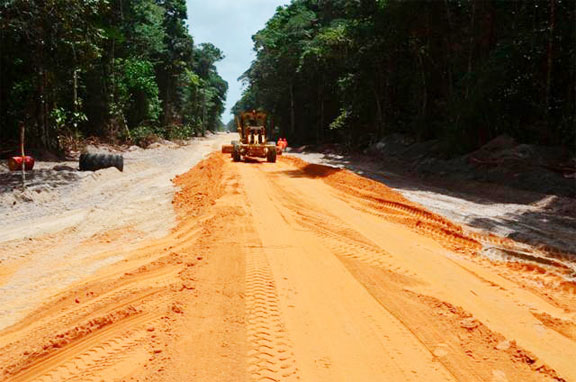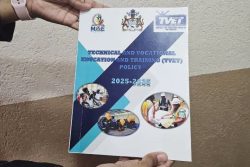Like the APNU+AFC did during its 2015 to 2020 tenure, the PPP/C government continues to maintain the Amaila Falls access road with Minister of Public Works Juan Edghill saying that it remains functional but needs maintenance soon.
Asked if the maintenance will be taken care of by his ministry, he responded that it was not in the current work programme.
However, this newspaper understands that work on the road will be done next year, even as government hopes that there will be heightened interest in the hydropower project.
The last report on the Amaila Falls Access Road was given in 2016 by the APNU+AFC, which said that it would continue to maintain it, while it mulled options for recovering the maintenance costs incurred yearly.
“We have to maintain the road because we paid for it and don’t want it to deteriorate,” then Minister of Public Infrastructure David Patterson had told this newspaper.
He had explained then that the government was, “trying to figure out cost recovery for it, what options are available. We are also going through several options, including having people pay to lease it and things like that, to go to or access their concession but we haven’t arrived at any decision on any of them as yet.”
Patterson’s predecessor Robeson Benn had said shortly before leaving office, that the cost to maintain the road would be some $200 million annually while pointing out that about US$28.9 million was spent to build the road.
Asked about current costs, Patterson had said he did not have figures at his disposal at the time of the interview, but that he would make them known as the works are overseen by the ministry’s Special Projects Unit.
Benn had defended the construction of the road after assertions were made that it was leading to nowhere. “The Amaila road project it is not a road to nowhere. It is a road to everywhere in terms of our economic development,” he had said.
He had stated that his government, the People’s Progressive Party (PPP), was working, both at the Ministry of Finance and Office of the President levels, to see the hydro project a reality and remained optimistic that soon an investor would be had and the project would kick off.
Sithe Global pulled out in August 2013 after failing to gain unanimous parliamentary approval of the Amaila Falls Hydropower Project (AFHP). Observers said that broad approval was required as the government was in the minority in the legislature.
But in December 2015, seven months after the APNU+AFC took office, it announced that Norway would fund a review to determine the viability of the project.
The project did not gain traction with the APNU+AFC, but the PPP/C, while in opposition, had hinted it would be revived should they return to office.
Months after the PPP/C took office in 2020, Vice President Bharrat Jagdeo had posited, “Amaila still remains the best option for meeting base load renewable energy for Guyana. That is the only way you can decarbonise, so the only way to achieve renewable energy is through the construction of the hydropower.” He was making reference to a Norway study done during the David Granger-led administration.
‘Hard time’
Then last May, Jagdeo had told a press conference that Chinese investor, China Railway Group Limited (CRGL), was unable to finance the construction of the roughly US$1billion project, and had written to the government requesting that it consider a different model of financing. That would have required, he noted, re-tendering for the controversy-riddled project.
He had said that CRGL was “having a hard time doing the BOOT (Build, Own, Operate, and Transfer) contract and they want to shift to an EPC [Engineering, Procurement and Construction] plus financing, where the government finances the project and they will be the contractors.”
According to Jagdeo, that suggested method of financing was not possible at the time, since those were not the terms under which the company had bid for the project.
“We are still in negotiations. We are still trying to get them to meet the commitment that they had bid for… If we can’t change that, we can’t get it done under the BOOT, we can’t proceed with the company, we will have to re-tender. We will not be able to conclude the contract,” he said
Government had been in negotiations since November 2021 and had not been able to make headway with an agreement on the project which has been on and off the agenda for over 15 years.
“The last six months we have been struggling to reach an agreement. We will have to give a deadline and cancel if they can’t proceed with the original model…,” Jagdeo said.
The Vice President explained that while this would delay plans for the energy sector, the PPP/C government remained committed to ensuring that the cost for energy was reduced by 50 per cent.
Pressed on what difficulties the company has been experiencing, Jagdeo replied, “They simply can’t raise financing.”
When asked if there are considerations to engage the second most competitive bidder, he desponded in the negative stating that that bidder proposed a higher retail figure per kilowatt hour – US 9.9 cents.
The company later pulled out.
CRGL, in its bid, proposed to sell electricity to the government at US$0.07737 per kWh. With the gas-to-energy project set to come on stream by 2025, Jagdeo had reasoned that it would not be feasible to lock in an agreement to purchase electricity higher than US 6 to 7 cents per kilowatt hour.
He stated that when the project was initially conceptualised and was being undertaken by Sithe Global (a subsidiary of Blackstone), the government was prepared to purchase electricity at US 10 cents per kilowatt hour since what was being generated cost twice as much.
Questioned whether the government was prepared to engage in an EPC financing model should the contract return to tender, the Vice President had said no consideration was given to that and it would have to be discussed extensively before any commitment was made.
While believing that the AFPH model is still viable and having received expressions of interest from foreign investors, the government last month announced that it would again seek Requests for Proposals (RFPs) for the project.
It is unclear what model would be used this time around, but it would be well thought out as government did not want to incur any debt.








